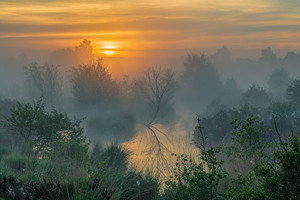Marches Mosses marks 30-year milestone and extends NNR
An internationally important lowland raised peat bog between England and Wales celebrates its 30th birthday as a National Nature Reserve (NNR).

Marches Mosses stores 3 million tons of carbon and is an important habitat. Credit: Stephen Barlow
The Marches Mosses, the UK’s third largest lowland raised peat bog, was once known as a source of peat cut for fuel and horticulture. Now it is a leading example of how peat bogs can fight against climate change if restored.
In 1990 ownership of the land was acquired by Natural England, Natural Resources Wales and Shropshire Wildlife Trust who began the process of restoring it before being joined by the European BogLIFE Project in 2016.
The 2,500-acre peat bog, which crosses the Wales-England border between Wrexham and Shropshire, has been cleared of trees and scrub, ditches have been dammed and bunds created to restore bog water tables to the peat surface.
The 30th anniversary will also see the NNR status being spread to incorporate a further 237 acres of peatland which have been added to the restoration work.
Tony Juniper, chair of Natural England, said:
Thirty years of action to revive one our largest peat bogs is paying dividends in helping to tackle the climate crisis and, at the same time, has boosted the survival of its rare ecology.
Places like the Marches Mosses are an example of what can be done to tackle the greatest environmental threat we face by simply allowing nature to recover and aiding that recovery with modern restoration techniques and protection through our designations as a National Nature Reserve and Site of Special Scientific Interest.
Although the Marches Mosses comprise Cadney Moss and two NNRs (Fenn’s, Whixall and Bettisfield Mosses, and Wem Moss), they are actually a single large raised bog - an acidic, wet habitat perfect for the Sphagnum moss which slowly decays and stores carbon as peat. It is only when this peat is cut, dug up and dried out – now mostly for horticulture use - that the carbon is released. That is why gardeners are encouraged to do their part in the fight against climate change by using peat-free compost.
Sir David Henshaw, chair of Natural Resources Wales, said:
Restoring and protecting peatlands is the only way we can safeguard their rich biodiversity and ensure they continue to deliver the full range of ecosystem services associated with these habitats, such as carbon storage, natural flood management and a range of other services.
This collaborative cross-border project, as well as other projects in Wales and beyond, will contribute in a very significant way to addressing both the nature and climate emergencies.
Richard Grindle, chair of Shropshire Wildlife Trust, said:
Shropshire has its part to play in reducing CO2 emissions and efforts to restore and expand sites like FWB Mosses will be a key factor in combating the climate crisis. But the Mosses are also home for rare insects and birds, which depend on the acidic nature of the peatland. Declining wildlife species have made a return to the area as the restoration progresses.
It is very encouraging to see what 3 decades of partnership work has created – imagine what can be achieved in another 30 years’ time!
Notes to editor
Marches Mosses is the shortened name for Fenn’s, Whixall and Bettisfield Mosses NNR, Wem Moss and Cadney Moss. It also sits within a Special Site of Scientific Interest (SSSI), a Special Area of Conservation (SAC) and a Ramsar Wetland of International Importance.
Natural England is the government’s independent adviser on the natural environment. Our work is focused on enhancing England’s wildlife and landscapes and maximising the benefits they bring to the public.
Natural Resources Wales champions the environment and landscapes of Wales and its coastal waters as sources of natural and cultural riches, as a foundation for economic and social activity, and as a place for leisure and learning opportunities. It aims to make the environment a valued part of everyone’s life in Wales. Marches Mosses has been supported by the National Peatland Action Programme, led by Natural Resources Wales and funded by the Welsh Government. For more see www.naturalresourceswales.gov.uk.
Shropshire Wildlife Trust is a conservation charity established in 1962 to conserve and protect Shropshire’s wildlife. This is achieved by directly conserving wildlife and habitat, undertaking research and reconnecting people with wildlife.
The Marches Mosses BogLIFE project is an ambitious 5-year, multi-million pound package of improvements and being delivered in a partnership led by Natural England, Natural Resources Wales and Shropshire Wildlife Trust. The funding has paid for the acquisition of a further 63 ha of peatland, and enabled water levels to be raised across 1890 acres to improve the raised bog habitat. New restoration techniques such as cell and contour bunding are being utilised to help the Mosses retain more water and prevent the peat decaying further, helping to counteract the effects of climate change. The project also aims to restore swamp, fen, willow and alder carr wet woodland, habitats missing from the edge of the bog and is a trial site for the conversion of pasture and forestry land on peat back to bog. Pollution at a former scrapyard on the peat bog is being cleared up and new visitor facilities created. This work is being generously funded by the European Union’s LIFE Programme and, thanks to National Lottery players, the National Lottery Heritage Fund.
National Nature Reserves (NNRs) were established to protect some of our most important habitats, species and geology, and to provide ‘outdoor laboratories’ for research. NNRs offer great opportunities to the public, schools and specialist interest groups to experience wildlife first hand and to learn more about nature conservation.